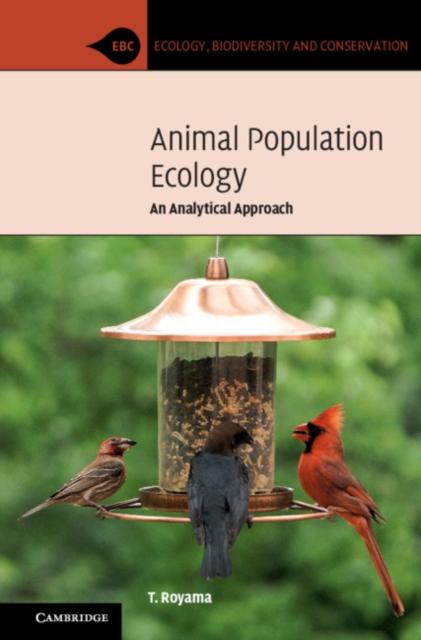T. Royama
Animal Population Ecology: An Analytical Approach
Animal Population Ecology: An Analytical Approach
YOU SAVE £1.97
- Condition: Brand new
- UK Delivery times: Usually arrives within 2 - 3 working days
- UK Shipping: Fee starts at £2.39. Subject to product weight & dimension
Bulk ordering. Want 15 or more copies? Get a personalised quote and bigger discounts. Learn more about bulk orders.
Couldn't load pickup availability
- More about Animal Population Ecology: An Analytical Approach
The study of animal population ecology focuses on understanding variations, regulation, and interactions of animal populations, including the logistic law of population growth, competition, sociality, predator-prey interactions, and resource competition. This book highlights the inadequate understanding of these concepts, leading to myths that can misguide ecologists in their studies.
Format: Paperback / softback
Length: 286 pages
Publication date: 22 April 2021
Publisher: Cambridge University Press
Animal population ecology is a comprehensive field that encompasses the study of variations, regulation, and interactions within animal populations. This book serves as a valuable resource for understanding the fundamental concepts and findings that form the basis of ecological research. In particular, the author delves into several key topics, including the logistic law of population growth, the nature of competition, the concept of sociality as an antithesis to competition, the mechanisms underlying population regulation, predator-prey interactions, and the complex dynamics of closely related species competing for essential resources.
While these notions are widely recognized as established facts or principles in the field of ecology, the author argues that they are often inadequately understood or misinterpreted, leading to the creation of myths that can misguide ecologists in their studies. To address this issue, the author takes a deep dive into these concepts, revealing their true nature and providing a roadmap for the future development of ecology.
One of the central themes of the book is the logistic law of population growth, which describes the exponential growth of a population when its resources are abundant and the rate of reproduction remains high. The author emphasizes that this law is not a universal rule but rather a generalization that applies to many animal populations under specific conditions. However, the author also points out that the logistic law is often misunderstood, leading to unrealistic predictions about population growth and its consequences for ecosystems.
Another important topic explored in the book is the nature of competition within animal populations. The author discusses the various mechanisms that drive competition, including resource allocation, predation, and interspecific interactions. The author highlights the importance of understanding competition in ecology, as it can have significant impacts on the structure, dynamics, and resilience of ecosystems.
Sociality, as an antithesis to competition, is another key concept explored in the book. The author argues that social behavior can have profound effects on animal populations, including increased survival, cooperation, and resource sharing. The author also discusses the challenges associated with studying social behavior in ecology, including the difficulty of quantifying social interactions and the complex nature of social networks.
The mechanism underlying population regulation is another important topic addressed in the book. The author discusses the various factors that influence population growth, including environmental conditions, resource availability, and demographic processes. The author also explores the role of natural selection and genetic variation in shaping population dynamics and the evolution of species.
Predator-prey interactions are a critical component of many ecosystems, and the book provides a comprehensive overview of these processes. The author discusses the different types of predator-prey relationships, including mutualism, parasitism, and competition, and the factors that influence these interactions. The author also highlights the importance of predator-prey dynamics in shaping ecosystem structure and function.
Interactions among closely related species competing over essential resources are another important topic explored in the book. The author discusses the various strategies that species use to compete for resources, including resource partitioning, niche differentiation, and aggression. The author also explores the ecological consequences of resource competition, including the impact on species diversity, population dynamics, and ecosystem function.
Throughout the book, the author emphasizes the importance of interdisciplinary research in understanding animal population ecology. The author discusses the contributions of other fields, such as genetics, behavior, and ecology, to our understanding of animal populations and the challenges associated with integrating multiple disciplines.
In conclusion, Animal Population Ecology: Concepts and Findings is a comprehensive and insightful book that provides a deep understanding of the fundamental concepts and findings that form the basis
the basis of ecological research. The author's clear and engaging writing style makes the book accessible to a wide range of readers, including students, researchers, and practitioners in the field of ecology. By delving into the complexities of animal population ecology, the book challenges the reader to think critically about the established facts and principles and encourages them to explore new avenues of research and inquiry. This book will undoubtedly serve as a valuable resource for anyone interested in advancing their knowledge of animal population ecology and its implications for conservation and management.
Weight: 474g
Dimension: 229 x 152 x 19 (mm)
ISBN-13: 9781108948166
This item can be found in:
UK and International shipping information
UK and International shipping information
UK Delivery and returns information:
- Delivery within 2 - 3 days when ordering in the UK.
- Shipping fee for UK customers from £2.39. Fully tracked shipping service available.
- Returns policy: Return within 30 days of receipt for full refund.
International deliveries:
Shulph Ink now ships to Australia, Belgium, Canada, France, Germany, Ireland, Italy, India, Luxembourg Saudi Arabia, Singapore, Spain, Netherlands, New Zealand, United Arab Emirates, United States of America.
- Delivery times: within 5 - 10 days for international orders.
- Shipping fee: charges vary for overseas orders. Only tracked services are available for most international orders. Some countries have untracked shipping options.
- Customs charges: If ordering to addresses outside the United Kingdom, you may or may not incur additional customs and duties fees during local delivery.


